


|
The front facade with three portalsScholars generally agree that the triple entry has sources in classical monuments in Provence--both the triumphal arch (the Arch of Tiberius in Orange has three arches, the central one higher than the side arches) and the Roman theater, which often had three doorways in the background set as well as niches with statues. (Again Orange in Provence could have provided a nearby model of such a theater.) (See Carra Ferguson O'Meara for a full chapter on the use of antique sources with particular emphasis on the derivation of the church facade from the Roman scaenae frons.) The entrance portals are recessed with carved tympana above the doorways. The lintels of the doorways are carved and connect with the friezes above the colonnades flanking the main portal. (See the pages on the relief friezes.) | |
The left or north tympanumDepicted in the center are the Virgin and Child with the Magi holding their gifts on the left and an angel appearing to Joseph on the right (Joseph's dream?). |

|
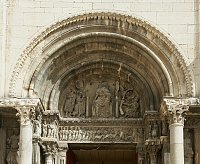
|
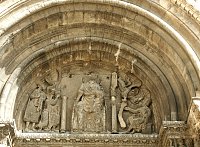
|

|
Decorative borders and revealing draperyA drill has been used to represent braid on the hem and cuffs of the garments of the Magi (as well as representing hammered? detail on their vessels). The drapery on both the Magi and the Virgin clings enough to reveal the anatomy beneath the garment. |
Dramatic gesturesAll of the figures on the sides exhibit dramatic actions, whether amazement in Joseph's case or adoration in the three Magi. The angel too swings downward. Both the angel and Magi are arranged artfully to follow the curves of the archivolts. |
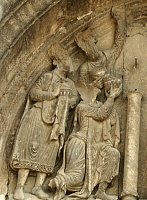
|
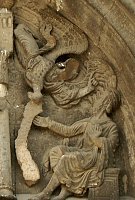
|
The central tympanumThis tympanum depicting the Second Coming was lost/destroyed and replaced in the 19th century. | ||
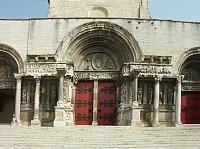
|
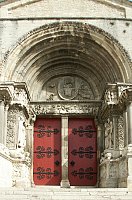
|

|
The right or south tympanumThis tympanum depicts the crucified Christ with the sun and moon above him. He is flanked by John and the Virgin Mary--as well as Church and Synagogue who is thrust to the ground by an angel. On the far left are the centurion and his assistant. O'Meara discusses the iconography of the fall or expulsion of Synagoga at length but sees this personification essentially as both an anti-semitic reference as well as an Anti-Christ reference, which, in the context of the Crusading spirit at Saint-Gilles, could also refer to Islam. She connects the crown of Synagoga with the Dome of the Rock, also seen in the Entry into Jerusalem on the frieze. | ||
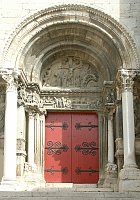
|
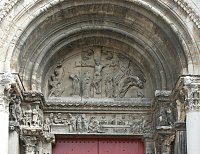
|

|
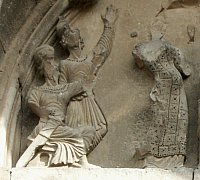
|
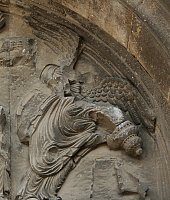
|
The personification of Church/EcclesiaEcclesia wears a robe with decorative panels, which O'Meara associates with the dress of Byzantine empresses. Synagoga's crown is in the form of a building. |
 Go to Saint-Gilles Index.
Go to Saint-Gilles Index.
 Click here to return to index of art historical sites.
Click here to return to index of art historical sites.
 Click here to return to index of artists and architects.
Click here to return to index of artists and architects.
 Click here to return to chronological index.
Click here to return to chronological index.
 Click here to see the home page of Bluffton University.
Click here to see the home page of Bluffton University.

